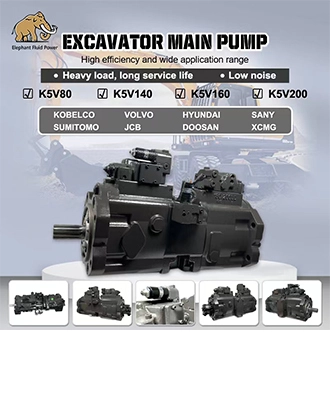Ⅰ. About the hydram pump
The hydraulic pump is the power component of the hydraulic system. It is driven by an engine or an electric motor, sucks oil from the hydraulic oil tank, forms the pressure oil and discharges it, and sends it to the actuator. Hydraulic pumps are divided into gear pumps, plunger pumps, vane pumps and screw pumps according to their structures.
Ⅱ. The composition of the hydram pump
The hydram pump consists of three parts: coupling, hydraulic oil tank and oil filter.
1. Coupling: The hydram pump drive shaft cannot withstand radial force and axial force, so it is not allowed to directly install pulleys, gears, and sprockets on the shaft end. Usually, a coupling is used to connect the drive shaft and the pump drive shaft. If due to manufacturing reasons, the coaxiality of the pump and the coupling exceeds the standard, and there are deviations during assembly, as the pump speed increases, the centrifugal force increases, and the coupling deforms, the deformation increases the centrifugal force. A vicious circle is created, which results in vibration and noise, which affects the service life of the pump. In addition, there are other influencing factors such as the looseness of the coupling pin and the failure to fasten it in time, and the wear of the rubber ring and the failure to replace it in time.
2. Hydraulic oil tank: The main function of the hydraulic oil tank in the hydraulic system is to store oil, dissipate heat, separate the air contained in the oil and eliminate foam. When selecting a fuel tank, first consider its capacity. Generally, mobile equipment should take 2 to 3 times the maximum flow rate of the pump, and fixed equipment should take 3 to 4 times. Secondly, consider the oil level of the oil tank. When all the hydraulic cylinders of the system are extended, the oil level of the oil tank should not be low. At the lowest oil level, the oil level should not be higher than the highest oil level when the oil cylinder is retracted; finally, considering the structure of the oil tank, the diaphragm in the traditional oil tank cannot play the role of depositing dirt, and a vertical diaphragm should be installed along the longitudinal axis of the oil tank. There is a space between one end of the diaphragm and the end plate of the fuel tank so that the space on both sides of the diaphragm is connected. The oil inlet and outlet of the hyd pump are arranged on both sides of the diaphragm at the disconnected end, so that the distance between the oil inlet and the oil return is the farthest. The hydraulic oil tank has more cooling effect.
3. Oil filter: Generally, pollutants with a particle size below 10 μm have little effect on the pump, while those larger than 10 μm, especially above 40 μm, have a significant impact on the service life of the pump. The solid pollution particles in the hydraulic oil can easily aggravate the surface wear of the relatively moving parts in the pump. Therefore, it is necessary to install an oil filter to reduce the pollution degree of the oil. Filtration accuracy requirements: 10 to 15 μm for axial piston pumps, 25 μm for vane pumps, and 40 μm for gear pumps. The pollution and wear of the pump can be controlled within the allowable range. At present, high-precision oil filters are widely used, which can greatly extend the service life of hydraulic pumps.
 French
French
 Portuguese
Portuguese
 Russian
Russian
 German
German
 Spanish
Spanish
 Japanese
Japanese
 Korean
Korean
 Irish
Irish
 Greek
Greek
 Turkish
Turkish
 Italian
Italian
 Danish
Danish
 Romanian
Romanian
 Indonesian
Indonesian
 Czech
Czech
 Afrikaans
Afrikaans
 Swedish
Swedish
 Polish
Polish
 Basque
Basque
 Catalan
Catalan
 Esperanto
Esperanto
 Hindi
Hindi
 Lao
Lao
 Albanian
Albanian
 Amharic
Amharic
 Armenian
Armenian
 Azerbaijani
Azerbaijani
 Belarusian
Belarusian
 Bengali
Bengali
 Bosnian
Bosnian
 Bulgarian
Bulgarian
 Cebuano
Cebuano
 Chichewa
Chichewa
 Corsican
Corsican
 Croatian
Croatian
 Dutch
Dutch
 Estonian
Estonian
 Filipino
Filipino
 Finnish
Finnish
 Frisian
Frisian
 Galician
Galician
 Georgian
Georgian
 Gujarati
Gujarati
 Haitian
Haitian
 Hausa
Hausa
 Hawaiian
Hawaiian
 Hebrew
Hebrew
 Hmong
Hmong
 Hungarian
Hungarian
 Icelandic
Icelandic
 Igbo
Igbo
 Javanese
Javanese
 Kannada
Kannada
 Kazakh
Kazakh
 Khmer
Khmer
 Kurdish
Kurdish
 Kyrgyz
Kyrgyz
 Latin
Latin
 Latvian
Latvian
 Lithuanian
Lithuanian
 Luxembourg
Luxembourg
 Macedoniar
Macedoniar
 Malagasy
Malagasy
 Malay
Malay
 Malayalam
Malayalam
 Maltese
Maltese
 Maori
Maori
 Marathi
Marathi
 Mongolian
Mongolian
 Burmese
Burmese
 Nepali
Nepali
 Norwegian
Norwegian
 Pashto
Pashto
 Persian
Persian
 Punjabi
Punjabi
 Serbian
Serbian
 Sesotho
Sesotho
 Sinhala
Sinhala
 Slovak
Slovak
 Slovenian
Slovenian
 Somali
Somali
 Samoan
Samoan
 Scots Gaelic
Scots Gaelic
 Shona
Shona
 Sindhi
Sindhi
 Sundanese
Sundanese
 Swahili
Swahili
 Tajik
Tajik
 Tamil
Tamil
 Telugu
Telugu
 Thai
Thai
 Ukrainian
Ukrainian
 Urdu
Urdu
 Uzbek
Uzbek
 Vietnamese
Vietnamese
 Welsh
Welsh
 Xhosa
Xhosa
 Yiddish
Yiddish
 Yoruba
Yoruba
 Zulu
Zulu







